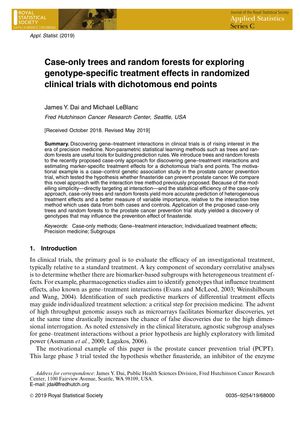TLDR Case-only trees and random forests improve predictions of treatment effects in clinical trials.
The study introduced case-only trees and random forests to identify gene–treatment interactions and estimate marker-specific treatment effects in clinical trials with dichotomous end points. Using a prostate cancer prevention trial as an example, the researchers demonstrated that these methods, which focus solely on cases, provided more accurate predictions of treatment effects and better measures of variable importance compared to the interaction tree method that includes both cases and controls. This approach showed potential in discovering genotypes that may affect the efficacy of finasteride in preventing prostate cancer.
 November 2020 in “Journal of The American Academy of Dermatology”
November 2020 in “Journal of The American Academy of Dermatology” Finasteride 1 mg every other month works as well as daily dose for hair loss maintenance.
June 2019 in “Journal of Drug Delivery and Therapeutics” Finasteride effectively treats hair loss and prostate issues with minimal side effects.
January 2013 in “China Medical Abstract of Dermatology” Finasteride effectively reduces acne with minimal side effects.
 12 citations
,
October 2004 in “PubMed”
12 citations
,
October 2004 in “PubMed” Finasteride, especially in a 1mg dose, effectively slows hair loss and improves hair growth in Japanese men with male pattern hair loss.
 38 citations
,
June 2003 in “Journal of Investigative Dermatology Symposium Proceedings”
38 citations
,
June 2003 in “Journal of Investigative Dermatology Symposium Proceedings” Finasteride effectively improves hair growth and slows hair loss in men with male pattern baldness.
 10 citations
,
June 2001 in “PubMed”
10 citations
,
June 2001 in “PubMed” Finasteride is effective in growing hair and stopping hair loss in men with mild to moderate alopecia.
 3 citations
,
October 1995 in “International Journal of Dermatology”
3 citations
,
October 1995 in “International Journal of Dermatology” Finasteride helps treat skin issues like acne and baldness by blocking testosterone conversion.





